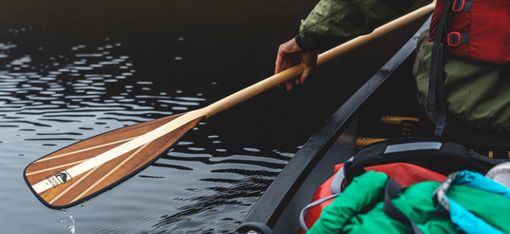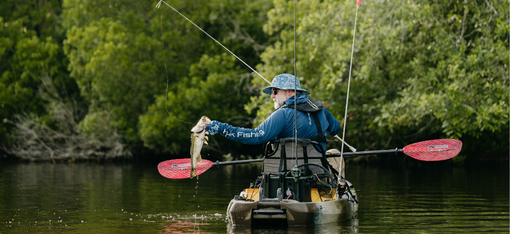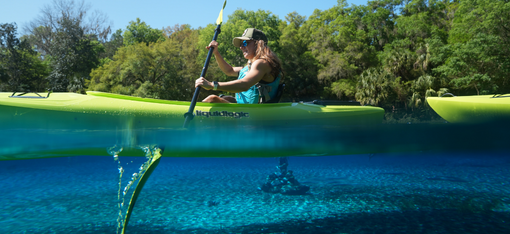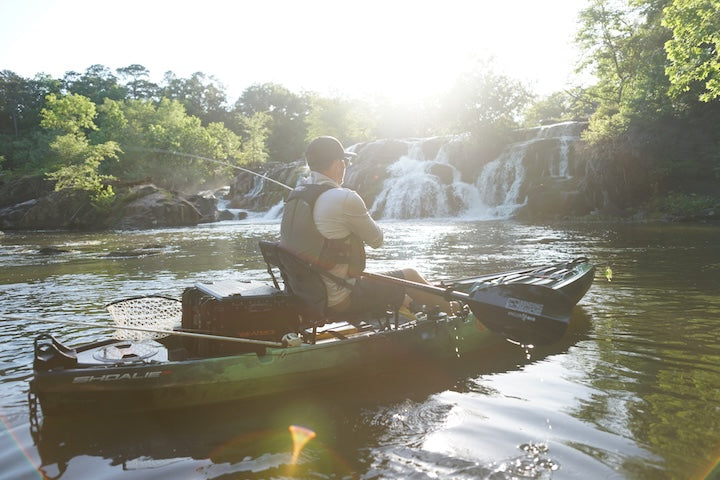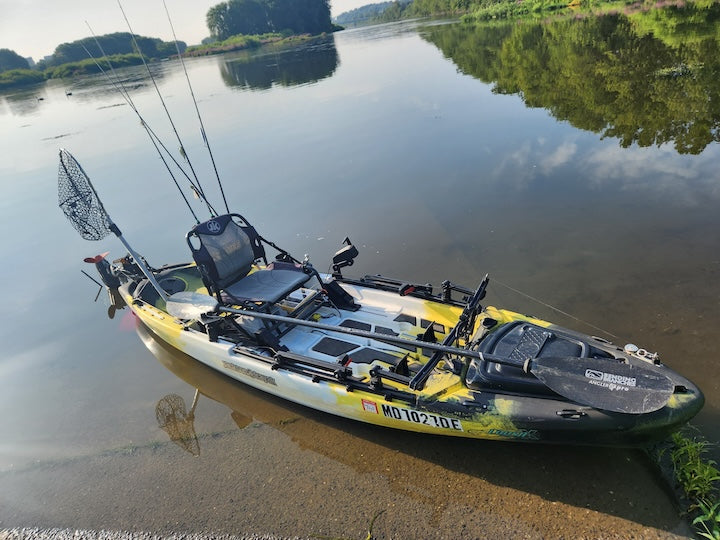Should You Use a Motor on Your Fishing Kayak?
8-minute read
Three of Bending Branches’ Ambassadors join us to offer their perspective and advice on the pros and cons of using an electric motor with your fishing kayak.

(Photo courtesy of Matt Trucks)
Matt Trucks, Matt Gibson and JR Rowlands are members of our Ambassador team. All three have experience using one or more types of electric motors while kayak fishing.
They’ve generously offered their perspective about using a motor, both the benefits and drawbacks. They also give their views on what type of kayak works well with a motor, and the type of motor they prefer.
First, though, let’s look at how fishing kayaks have developed over the years.
The Evolution of the Fishing Kayak
Matt Trucks offers a helpful overview of how kayaks used for fishing have changed over time:
“In the early years I learned to become a very strong paddler. Both technique and fitness were important. Back in those days, fishing kayaks were recreational kayaks—typically sit-on-tops—that we anglers rigged with aftermarket rod holders and milk crates for tackle storage. It was all very innovative DIY at the time. Most of this has been revamped these days by kayak fishing accessory manufacturers.
“The kayaks of ‘the old days’ were built for paddling. An ideal paddling kayak tracks well and is narrow, for speed. As time passed, the fishing kayak became a wide, stable, flat platform that has a minimum weight capacity of over 400 pounds. I wonder if we can even call them kayaks anymore?
“With the heavy, barge-type fishing concept, paddling against heavy current and wind became impossible. Hence, the pedal-style boats became more popular. But the pedal kayaks, in my opinion, have their flaws.
“Pedal systems break down. Now you’re forced to paddle a big and heavy pedal boat with a giant hole in the center that becomes a water brake. It’s just not a good day after that!
“Electric motors, although expensive, are the better option. The angler can purchase a paddling-style kayak and still use it to paddle, or use the power of an electric motor. The price averages out to around the same as a premium pedal kayak.”

(Photo courtesy of JR Rowlands)
Benefits of Fishing with a Motorized Kayak
Matt Gibson loves using a motor because, “It allows me to cover water in an efficient manner. It really holds me in good fishable water no matter the conditions.”
JR Rowlands adds: “Using a motor while kayak fishing has become a major asset. First, from a physical energy standpoint I can travel greater distances without fatigue being an issue.
“Second, pinpoint GPS is huge when it comes to holding position in the wind. Being able to lock myself down in a given spot means more time fishing and less time fighting the conditions on any given day.
“Finally, like many of the items we have on our kayaks, it’s another tool in the belt. It may not be a necessity, but it’s sure nice to have!”
Matt Trucks’ opinion is that an electric outboard with a foot brace steering system is the very best way to kayak fish hands-free.
“Fishing with a paddle actually decreases your fishing time by about half in moving water and wind,” he says. “Using a foot-steered electric outboard means your hands can be on the fishing rod at all times, or tying on a new lure, having a snack or taking photos.”
Matt fishes exclusively saltwater, so he spends much of his day searching, watching the sonar and trolling. He finds using an outboard electric motor is the best way to do that efficiently in his kayak.
Drawbacks of Fishing with a Motorized Kayak
The first drawback of using a motor is the cost. A bow-mounted trolling motor will be a few hundred dollars, and outboard electrics can be a thousand or more to purchase, plus some maintenance costs. The batteries—a deep-cycle marine or lithium battery—start at $100+ and run upwards of $800+.
Secondly, a motor and battery add weight to your kayak. JR says, “Many kayaks today have mounts specifically for these motors, but you still have to account for the additional weight added by both the motor and the battery. Lithiums have eased that a bit, but you still have to account for it.”
He adds, “Setup and breakdown takes a little longer. Quick-release connections make it easier, but it’s another step you must do before and after each trip.”
Matt Gibson agrees. “It does add weight and some complexity to my fishing day,” he says.

(Photo courtesy of JR Rowlands)
Matt Trucks also notes issues in the shallows. He says, “Shallow water is a concern where the motor needs to be tilted up. It doesn’t function along the areas with downed trees, heavy weeds and stumps.”
“With a motor you need to be cautious of what’s around you at all times,” continues JR. “Full speed into a stump can be unsettling (ask me how I know)! Life is made easy with the cable retractors, but you may have to do that routinely if you’re fishing in pads, stump fields or shallow areas.”
Another drawback is you’ll need to keep tabs on your battery’s life. As JR says, “It can make or break a fishing trip. Lithiums have eased these concerns, but they haven’t eliminated them.”
“Although I have yet to run out of battery,” says Matt Trucks, “it could be a concern. Mechanical failure will happen eventually, so be prepared to paddle all the way back to the put-in.”
Why You Still Need a Quality Paddle
“The paddle is still a tool you need every day,” says Matt Trucks. “I never leave the shore without it. The paddle is used to drop in and pull out at the launch, to push off the banks or out of shallow water. I use it to reach back to get fishing lines that are tangled on something out of reach. And if something breaks, well, it's always there to save you!”
JR agrees: “Always carry your paddle even if you run a motor. My choice is the Bending Branches Angler Pro. The worst thing you can do is trek across a large body of water to realize you now have a dead battery. You then have a nice upper body workout ahead of you! At least you have the best paddle in the business to get you back, right?”
Matt Gibson also values his paddle. He says, “There are times when there’s vegetation, or the water I’m fishing is too shallow for a motor. A good paddle allows me to get where I need to go without the motor.”
Recommendations for Motors and Kayaks
Both Matt G and JR use the NuCanoe Unlimited as their main fishing kayak. Matt says, “Some kayaks are better than others when it comes to being able to mount a motor on them. The NuCanoe platform is super easy to install a bow-mount motor or a transom-mount motor.” [You can view wiring videos here.]
He uses the Motorguide Xi3 trolling motor. “Installation on and off of my NuCanoe Unlimited is quick and easy. The pinpoint GPS really allows me to stay in one spot and thoroughly fish an area. If I’m looking to cover a lot water from a ramp, the Newport motor is a great choice.”
Matt T likes an electric outboard like the Torqeedo Ultralight over a bow-mounted model.
JR says, “I personally run the Motorguide Xi3 on my NuCanoe Unlimited. With their 36" kayak version, it makes rigging your kayak fairly straight forward. By no means is this your only option, though.
“I’ve shared the water with individuals using transom-mount trolling motors, Minn Kota versions and many others. Ultimately, with a little work you can make many of these motors work on a kayak.

(Photo courtesy of Clay Grace)
“The bigger question would be the platform you're building on. It's easier and safer to add a motor to a kayak designed around a motor, versus slapping a motor onto a kayak that was never designed for one.
“Nowadays there are mounts to accommodate motors for most major kayak brands, but you should still use caution. Weight restrictions still play an integral part in your decision process.
“Do you plan to run lithium batteries or more traditional batteries? Make sure the kayak you're working on can accommodate the additional weight. For example, my Unlimited has a max weight of 650 pounds, giving me the ability to build out the way I do.”
A big thanks to Matt, Matt and JR for their insight and suggestions!
Do you have paddle questions our friendly Customer Service Team can help you with today? Contact them: 715-755-3405 • [email protected]
More for you...




